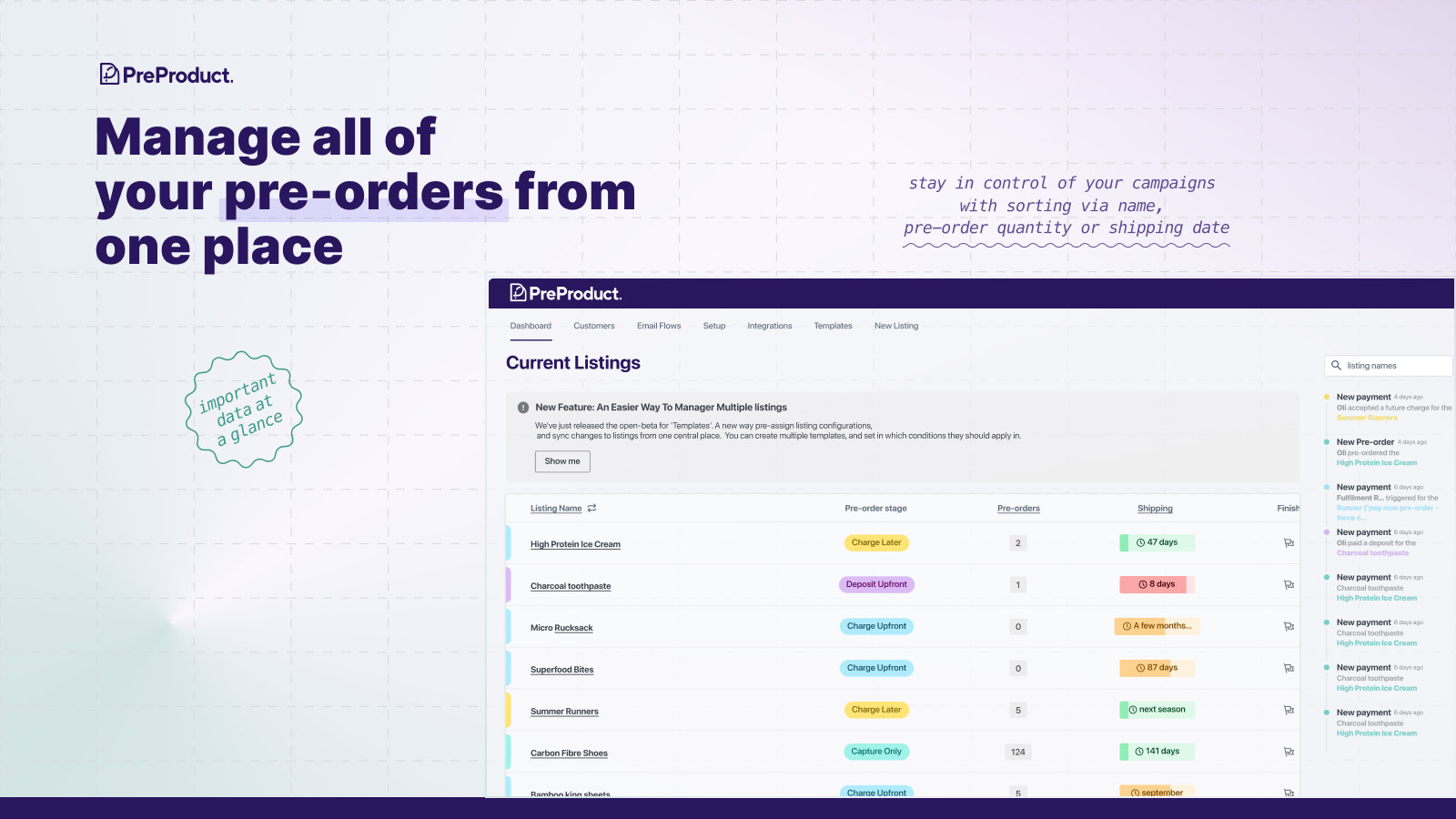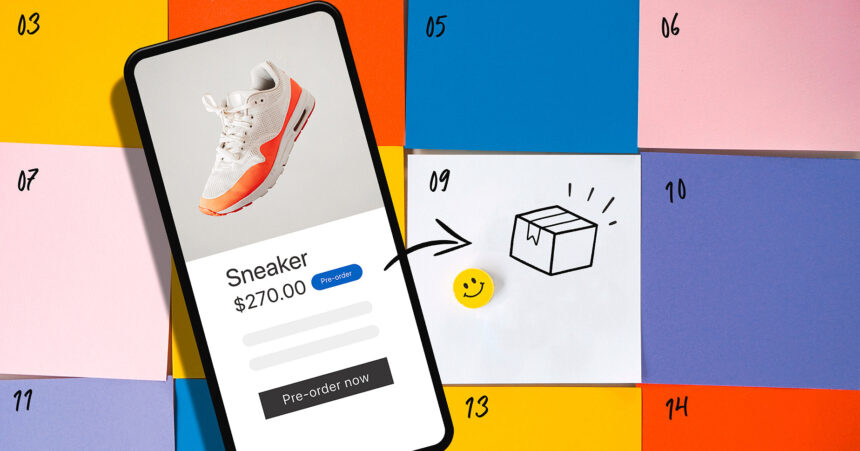When Tom Petty sang, “The worst part is waiting,” he probably wasn’t thinking about the delivery of his latest online order. But in e-commerce, anticipation is a powerful lever.
Pre-orders create excitement for customers as they wait for new products to arrive at their doorstep, and for retailers, pre-orders convert potential sales into purchases, increasing revenue and improving customer relationships.
In this guide, we’ll explain how pre-orders work and how you can use Shopify to enable pre-orders for your customers.
What does pre-order mean?
Pre-orders allow customers to place an order before a product is released or restocked. Full or partial payment is taken at the time of pre-order, but the order will only be shipped once it is available.
Whether a product is out of stock or coming soon, pre-ordering acts as a reservation that gives customers access to it once it’s available.
When a merchant accepts a pre-order deposit, they often charge the remaining balance using the customer’s saved payment method.
💡 Check out our collection Pre-order the app.
Why pre-ordering makes good business sense
Pre-orders offer significant advantages and positively impact revenue, operations, and customer loyalty.
Increase sales
Customers have more choices than ever before when it comes to shopping. E-commerce has essentially put the entire world at their fingertips, with everything from unique custom crafts to high-end luxury goods and electronics just a tap away.
For retailers, this means competition is fiercer than ever: if a shopper wants a product and it’s unavailable or out of stock, they’ll move on to the next store.
Pre-ordering gives you the advantage of securing more sales whether your items are ready to ship or not. When your customers are ready to buy, you’ll be ready to sell, so you’ll never have to say “no” to a customer again (even if they’re not ready to ship).
Plus, pre-ordering gives you the flexibility to take a deposit, payment up front, or payment once the goods are shipped, making it easier to tailor your strategy to fit your unique cash flow needs.
Anticipate demand by meeting it
Pre-ordering helps turn uncertainty into insight by providing concrete demand data that companies can rely on.
Selling physical products is inherently risky. Whether they’ve invested in researching, designing, and manufacturing their products, or simply purchased inventory, retailers have a significant financial interest in knowing exactly how much demand there is for each product they offer.
For distributors who want to make any tweaks or final adjustments before bringing a product to market, pre-orders help you know exactly what your customers will like before production ends. While “gut instinct” works for some business geniuses, for the rest of us, pre-orders give you a great, realistic picture of what sizes, colors, and options you should produce to meet existing customer demand and be able to ship within a reasonable time frame.
In the past few years, Supply chain issues This can cause major problems for even the most established businesses. Pre-ordering effectively forecasts the minimum quantity of product needed to fulfill an order, reducing the risks associated with managing an uncertain supply chain and storing idle inventory. Large delays like these must also be taken into account when estimating shipping schedules.
Generate excitement and foster growth
Between targeted advertising and the dozens of screens the average shopper sees every day, it’s tough for retailers to break through the noise and grab their attention. This makes it especially difficult to build awareness and anticipation for a new product release or the return of a fan favorite.

Just like movie trailers slowly build up before a movie is released, pre-orders help build anticipation and excitement for your product before it hits the shelves. A successful pre-order marketing campaign follows many of the same tips as a regular marketing campaign, for example:
- Create professional product images and copy. If your product images don’t exist yet, we can also help you create them using factory samples and professional retouching services.
- Advance reservation benefits are also available. Limited-time discounts, early access to release news or other products, and free customizations are great ways to generate excitement and encourage pre-sales.
- Paid media and social media promotion. Whatever digital platform your target audience uses most, make sure you post your pre-order news there.
In addition to generating buzz, offering customers exclusive pre-order access through a mailing list or member loyalty program will not only increase the conversion rate of these returning customers; Brand loyalty It shows your customers that you appreciate their business and understand what they want to buy.
How to pre-order
Pay now
Pay Now is the most common type of pre-order. You must pay the full sale price of the item at the time of pre-order, and payment is made just like a regular purchase. You can think of this as roughly the same as a standard sale with an extended fulfillment time.
For pre-orders, customers will receive information explaining the expected shipping date.
Pay now pre-orders are ideal for businesses that want to:
- You get paid up front. If managing your cash flow is important to you, paying now can help ensure you always have the cash you need on hand.
- Capture your customers in the moment. Worried about missing a sale because you’re out of stock? Pay now means your sale will run whenever shoppers are ready to buy.
- Automatically update out-of-stock items. Many pre-order apps can be set up to automatically accept pre-orders when an item is out of stock, meaning fewer customers will move on to another seller.
- Keep your customers informed. The message on your Pay Now pre-order site can be customized to display additional information, such as an estimated shipping date.
Pay Later
Another type of pre-order is pay later, where a customer can make a “reservation” for an item with or without upfront payment, and then the remaining balance or full sales price is charged after the item has been shipped.
Pay later pre-orders are ideal for businesses that:
- Get orders for upcoming products that may be delayed. Choosing to pay later gives you more flexibility when it comes to notifying your customers that their product will be shipped later than expected.
- Test the market for new products. Deferred payment allows them to gauge interest in new products and produce appropriate quantities.
- Invoice your customer upon fulfillment. If you want to customize your cash flow, deferred payment allows you to invoice your customers before or after you pay your suppliers.
How to Set Up Pre-Orders in Shopify
Pre-ordering is complex, and there’s rarely a single pre-ordering method that works for everyone. So we’ve partnered with the app ecosystem to make it easy for them to build the best pre-ordering apps on our platform, and every pre-ordering app they install works seamlessly with Shopify.

Popular pre-order Shopify apps
When you’re ready to start offering pre-orders, try one of these pre-order apps available in the Shopify App Store.
Pre-product

Pre-product Accept pre-orders for your upcoming product launches at any point in your product cycle. Choose from deferred payment or deposit-based pre-orders, and charge your customers only when you’re ready with a payment link or deferred payments.
Endless Braiding Co., Ltd. We manufacture precision, multi-setup inline skate frames and use PreProduct for pre-ordering, making it easier to forecast demand and place orders with our vendors.
Pre-Order Manager

Pre-Order Manager It makes it easy to automate pre-order dates and enable pre-order dates based on inventory levels.
Earth Bit, A zero-waste beauty and cleaning store uses Pre-Order Manager to pre-order one of hundreds of products when it runs out of stock.
The company said Pre-Order Manager has “reduced a lot of customer service overhead” by giving customers full visibility into when they’re ordering out-of-stock products and when they’ll be restocked.
Purple dot

use Purple dot Set up 100% late payment terms: your customer’s card is saved at checkout and charged when the product is ready to ship.
Menswear Brands talked uses Purple Dot for pre-ordering and gives you the flexibility to launch products on your schedule, whether that be in stock or with a lead time.
SPOKE says that pre-orders have allowed it to “achieve a 400% higher sell-through rate than we would have expected if we had had to wait.”
💡Each app seamlessly integrates with Shopify, so choose the one that’s best for your business. Explore more options here. Shopify’s collection of pre-order apps.
Build your own custom pre-order solution
Existing merchants with complex needs can build their own pre-order flow with Shopify. Pre-order APIThis tool makes it easy for partners and developers to build new pre-order experiences directly within Shopify Checkout.
Expected Sell
By offering pre-orders, you’re not just selling a product, you’re selling an experience. Beyond the transaction, pre-orders are about creating excitement, giving customers something to look forward to and making them feel like they’re part of something special.
Pre-order FAQ
Can I pre-order a product before it is produced?
Unless expressly communicated to customers, items must begin production before they are available for pre-order.
Can I pre-order if I don’t know when the item will ship?
Based on your understanding of the industry, you should be able to suggest a reasonable time frame for shipping the product. If no date is specified, the item should be shipped within 30 days.
Can I change the shipping date?
If you can’t fulfill a pre-order within the specified time, you must change the shipment date and explain the customer’s rights to cancel or request a refund.








